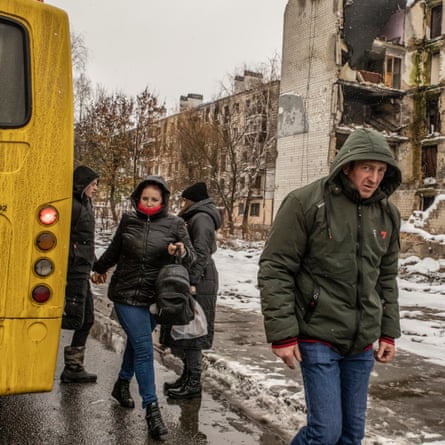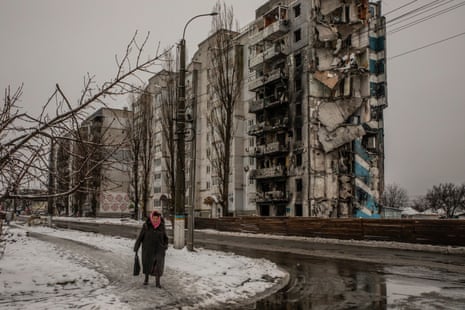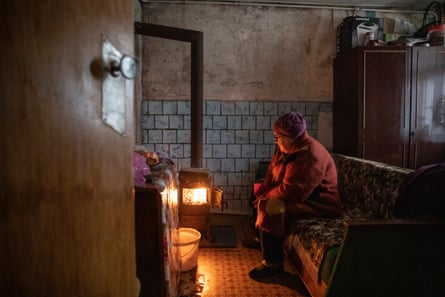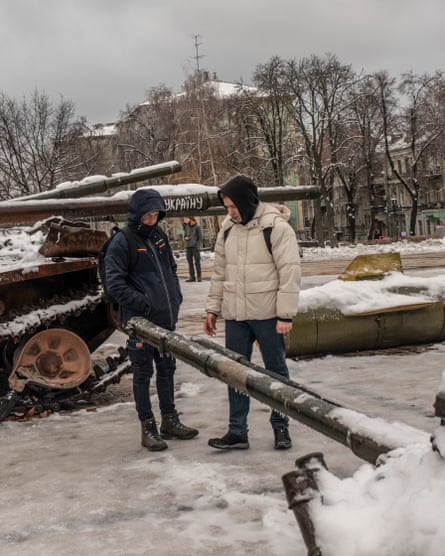Onset of winter in Ukraine – a photo essay
Published by The Guardian, 29 November 2022
After Russian attacks on energy infrastructure, this is expected to be the hardest winter in Ukraine since the second world war
The defining image of the current state of the war in Ukraine – and at the same time a metaphor for the entire country – is the snow-covered rubble of a residential building split in two by a Russian bomb in the town of Borodianka.
Some people who lived in that building have died as a result of the conflict. Others have managed to escape, joining the great exodus of refugees toward Europe. Some are now living in a dormitory on the outskirts of the town, struggling, like millions of other Ukrainians, with the nightmare of what is expected to be the hardest winter in the country’s history since the second world war.



- Top left: residents of Borodianka disembark from a bus in a street heavily bombed by Russia. Top right: the rubble of a house in Borodianka. Above: an elderly woman walks by the snow-covered rubble of a residential building in Borodianka
In an effort to force Ukraine to negotiate a peace, in recent weeks Russia has been trying to destroy the country’s energy infrastructure with a series of mass strikes. No energy system in the world has been subjected to such powerful attacks, and now a long period of blackouts is looming. More than 6 million Ukrainians are being plunged into extreme hardship. The World Health Organization did not mince its words last week when it said: “The destruction of houses and lack of access to fuel or electricity due to damaged infrastructure could become a matter of life or death.”



- Top: Kateryna Sliusarchuk, 71, warms her house using a burzhuika, a homemade welded metal stove. Above: Kherson residents crowd around a volunteer aid truck to receive food
In Kherson, recently liberated from Russian control, people have started gathering wood – not a simple task in a war-torn country – in preparation for winter. “I have already started using the burzhuika,” a traditional homemade welded metal stove, said Kateryna Sliusarchuk, 71, as temperatures dropped close to zero. “Of course, I’ll have to wave my arms around and look for wood every day to protect myself from the cold. And it won’t be easy at my age.”
Ukrainian authorities have advised citizens not to head into the woods without consulting the military, because Russian troops may have left behind mines, tripwires and unexploded shells. But with the price of firewood rising, many have no choice but to take the risk. If a mine doesn’t kill them, the cold might.

A police checkpoint near a residential building hit by Russian missiles in Vyshhorod, a suburb in Kyiv
While people living in houses can burn wood – if they can get it – those who live in flats often rely on old Soviet centralised heating systems. The Russians have bombed many of the country’s thermal power plants, which used to pump hot water into the radiators. For these people, the majority of the population in the cities left without electricity, there are few alternatives other than to move into dormitories or tents installed by Ukraine’s state emergency workers that provide heat, food, water, internet, mobile phone connections and a pharmacy. Authorities have warned of power cuts that could affect millions of people through to March.

- Ruslan Vorona and his eight-year-old son Oleksii, from Vyshhorod, sheltering and charging their phones in an insulated tent set up by the emergency services
Hundreds of thousands of houses in Ukraine have been destroyed by the Russians. Many were razed to the ground, others were partially damaged. In some houses, it was still possible to live there during the summer, and partly in the autumn, but with winter approaching it is impossible. In Borodianka and Bucha, two towns north of Kyiv that were pummelled by Russian bombs and then occupied, temperatures in winter can drop to -8C at night. Last March, the Russians dropped bombs on the towns’ residential areas. Many residents today live in shipping containers.

Tetiana Martynova, 60, lives with her four cats, two dogs and a rabbit in the rubble of what is left of her home
In Borodianka, the home of 60-year-old Tetiana Martynova and her brother was heavily damaged by Russian bombs. She lives with her four cats, two dogs and a rabbit in what is left of it. “I love these kitties. I love all animals. I have three more kittens I found in a dumpster. I took them into the garage I’m renting,” she says. “It will be hard for the winter, but I don’t want to leave my house. Who is going to take care of my pets if I leave?”
At night, Martynova has to move into a dormitory, which was also damaged by the bombings. Melting snow seeps through the roof, making life even more difficult for guests.



Top: a street vendor sells fruit in Kyiv. Above left: snow-covered rooftops in the capital. Above right: Maidan Square in Kyiv covered in snow
If it were not for the war, children would have crowded the squares, parks and streets this week to play in the first snow of winter. But this will be a season like no other. The mayor of Kyiv, Vitali Klitschko, said 60% of households in the city of 3 million people had no power, and there were rolling blackouts around the country as engineers struggled to repair transformers and transmission lines damaged or destroyed by cruise missiles last week.

A woman lights a candle at St Michael’s Cathedral in Kyiv
Ukrainians are well aware that their own morale has become the central battlefield of the war, and it is not territory they are prepared to concede to Vladimir Putin. In Kharkiv and Kyiv, they find shelter from the cold in insulated grey tents set up by the authorities. The temperature outside hovered just above zero and a frigid rain fell, melting the snow of recent days and filling the streets with dark slush. There was water everywhere, but very little to drink. There was no power for the water pumping stations.



- Russian tanks captured by Ukrainian troops are put on display in Kyiv
Russia has used the iconography of the second world war to maintain Russian public support for the invasion. But Ukrainians are quick to point out that that victorious struggle is their legacy too, and they draw lessons in resilience from it. “We are Ukrainians. We’re strong and we can get through this,” said Angelina Anatolieva, 50, from Pecherskyi. “Do you remember the siege of Leningrad? They lived through that, and we can live through this. We can live through anything.”

- A family cook outside the basement of their house. Owing to the Russian bombardments, light and electricity were cut.
The impending cold is a problem not just for Ukrainians. As temperatures drop, it will become increasingly difficult for the poorly equipped Russian army to move through the rain, mud, snow and frost. It is one thing to move heavy artillery through the forests in the summer and another to do it in the freezing, windswept steppes of the Donbas, where temperatures can drop to -30C.
The Ukrainian army said its soldiers had received sleeping bags that are supposed to be good down to that temperature, as well as special underwear and tactical socks to avoid trench foot – a type of wound caused by prolonged exposure to damp and cold, which was widespread during the first world war.



- Top left: an elderly man walks past the snow-covered rubble of a residential building in Borodianka. Top right: Vasyl, a Borodianka resident, shovels snow in front of his house. Above: from left, Vlad, Maxim and Artem, from Borodianka, wear newly bought Santa Claus hats
Ukraine’s president, Volodymyr Zelenskiy, has known for months that the cold is one of the biggest obstacles in this war. Even at the end of August, he was warning the population about “difficult times ahead”. Last week, Zelenskiy was even clearer. “If we survive this winter, and we will, Ukraine will definitely win this war,” he said.
https://www.theguardian.com/world/2022/nov/29/onset-of-winter-in-ukraine-a-photo-essay

